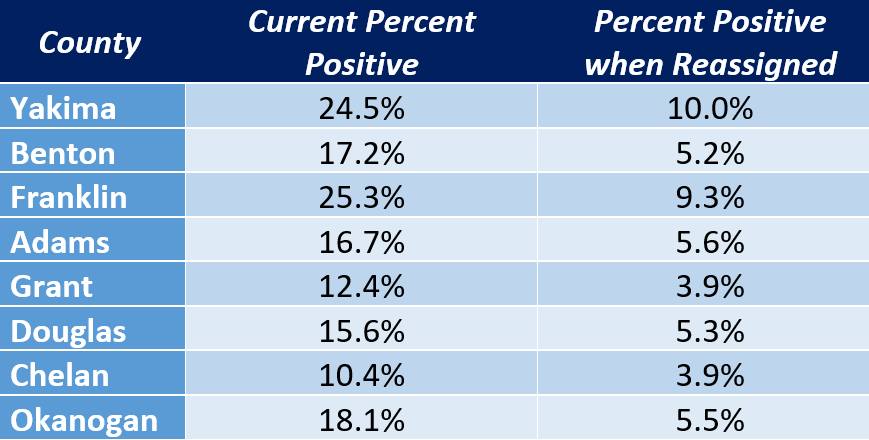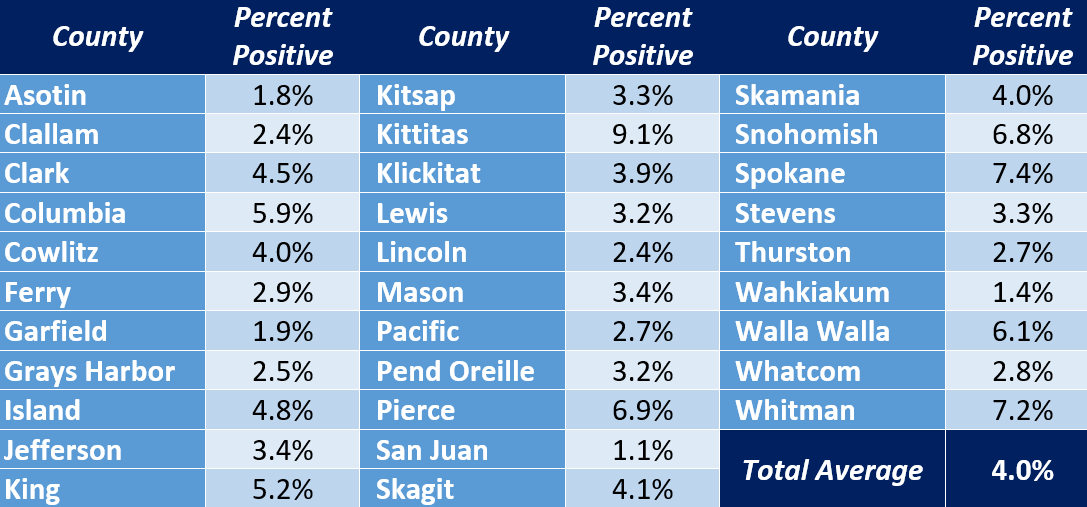Basket Case
No "State of Emergency" permits sloppy data keeping.

“The true source of our sufferings has been our timidity.” – John Adams
The Problem
In Washington, 1 in 5 COVID-19 tests is being thrown out. These thrown out tests land in a basket labelled “Unassigned,” and it’s unknown which counties these results belong to. The “Unassigned” basket is a massive wildcard, as it carries the potential to free counties in Washington from Inslee’s economic and religious suppression. The very existence of this basket is legally questionable, and no one seems to be asking questions.
The “Unassigned” Basket
-
On July 1st, there were 120,000 tests considered “Unassigned” to a county. By August 1st, there were 200,000 tests. The “Unassigned” basket is consistently 20% of the entire state’s tests.
- The basket is always 99.9% full of negative tests.
- On an average day, 1 positive test and 1,288 negative tests are added to the “Unassigned” category.
-
The list is always changing because the state DOH is trying to remove and assign these tests to the right county.
- Anywhere from 15 to 3,727 tests have been removed in one day.
- As many as 4,792 negative tests have been added in one day.
-
There have been “Unassigned” tests dating as far back as March 1st, 2020 – the very beginning of the COVID pandemic.
- At this point, the entire state was conducting less than 100 tests per day, making “laboratory backlog” an explanation untenable.
The Law: WAC 246-101 – Notifiable Conditions
The Washington State Department of Health classifies COVID-19 as a “Notifiable Condition.” This means local and/or state health authorities must be notified if someone tests positive for COVID.
Throughout the law, there are chains of patient information that must be maintained. This is because a person’s COVID test sample could be transferred several times. A COVID test sample often goes from the patient to the provider, to the state’s Public Health Laboratory, and possibly to another lab (if the Public Health Lab is overwhelmed).
In the event that a healthcare provider can’t determine a patient’s residence, the provider must report the location of the local health jurisdiction – like the Yakima Health District. Across Washington, there are 35 different local health jurisdictions (39 total counties).
There is, therefore, no reason a county’s information should ever be unassigned.
Information Seeking Part 1: Emails
I first noticed the “Unassigned” tests on the Washington State Department of Health webpage and decided to email their main press outlet – the Joint Information Center. They gave me the runaround and eventually stopped replying to my emails. No questions were answered.
I asked the Yakima Health District about the “Unassigned” tests and whether any potentially belonged to Yakima County. I was informed that if there were any “Unassigned” tests belonging to Yakima, they likely came from a backlog with Indian Health Services that happened in mid-July. Unfortunately, this answer is mathematically impossible. The Yakima Health District supposedly received over 213 tests from the backlog. For the appropriate time frame, the state Department of Health removed less than 75 “Unassigned” tests.
I decided to email the state’s Public Health Lab. They told me that “Unassigned” tests were likely due to incomplete residential information – like a phone number, but no address. I asked the Public Health Lab if there was any attempt to assign the “Unassigned” tests by phone area code or by which provider sent in the sample. The Public Health Lab said they “can’t speculate on the ability to do that.”
According to WAC 246-101-205, laboratories should be able to categorize and retrieve information like patient zip codes, provider address, etc. There shouldn’t be speculation.
Information Seeking Part 2: Public Records Requests
Everyone I emailed recommended I make a public records request. I made one with the state and one with Yakima County. In both, I asked for a complete breakdown of which labs processed all of Yakima County’s COVID-19 tests, along with how many negative and positive tests came from each lab.
The state said that 33,180 tests had come through the Public Health Lab for Yakima County (29,031 negative, 4,019 positive, 127 inconclusive, and 3 invalid). This number was about 7,000 tests short of what the state Department of Health was reporting for Yakima. The state told me to check with two other labs that COVID tests had been outsourced to (apparently, the Public Health Lab didn’t have that information). I contacted Northwest Labs and UW Labs with similar questions. Neither replied.
The county redirected my request to the Yakima Health District. I was informed that:
“The Yakima Health District does not keep a list of certified laboratories that report to YHD nor do we keep a list of positive and negative samples received by each laboratory. The State Department of Health certifies laboratories and maintains the data base WDRS (Washington Disease Reporting System) in which we get data.”
I asked several follow-up questions with the Yakima Health District (their full reply was in red):

It appears that laboratories are the main controllers of COVID data, not necessarily local health jurisdictions like the Yakima Health District.
The Implications
In the law, there’s little guidance about how to handle negative tests. While positive tests must be reported to everyone involved, the state isn’t really required to keep tabs on who tests negative. The problem is that there are five metrics for counties to move through Phases. Two of these metrics deal with the ratio of positive to negative tests:
- Percent of individuals testing positive.
- If 100 people in Yakima got tested for COVID, and 15 people tested positive, this would mean that Yakima has a 15% positive.
- The state’s goal for counties is under 2% positive.
- Yakima is currently between 20-25%.
- If 100 people in Yakima got tested for COVID, and 15 people tested positive, this would mean that Yakima has a 15% positive.
- Number of individuals tested per new case found.
- If the number is “6”, then for every 6 people getting tested, 1 person is positive.
- If the number is “40,” then for every 40 people getting tested, 1 person is positive.
- The state’s goal is over 50 people for every positive case discovered.
- Yakima is currently at 4 people for every positive case.
A Little Math
Across the state, the average percent positive is 4-6%. However, there are still 8 counties sitting above 10%. The “Top 8” counties are all on the east side of Washington – despite the west side having higher transmission rates. Five of the “Top 8” counties can’t seem to move out of “modified” Phase 1, either.
I ran some math to see what it would look like if we emptied the basket and reassigned the “Unassigned” tests to the “Top 8” counties. Because some of the “Top 8” counties are much larger than others, I reassigned the tests by population:

When the “Unassigned” tests are reassigned, the “Top 8” counties begin to look like the rest of Washington:

August Data Changes
For the month of August, the state Department of Health has had difficulty reporting negative tests. As of August 12th, the state Department of Health is reporting all COVID tests, rather than just the current results of individuals.
For example: If someone was tested 10 times, all 10 tests will now be reported rather than just the 1 positive or negative test that’s most current. While this new method isn’t fully in place yet, some preliminary data was released. It appeared to drastically increase the percentage of people testing positive. This happened in two ways:
-
Massive subtraction of negative tests – Hundreds or thousands of negative tests were removed from almost every county in the state.
- Yakima County alone preliminarily lost 5,769 negative tests and only gained 1 new positive test.
- This was enough to increase its percent positive by 3.8%.
- In contrast, King County preliminarily lost 28,283 negative tests and gained 15 positive tests.
- This only increased its percent positive by 0.56%.
- Yakima County alone preliminarily lost 5,769 negative tests and only gained 1 new positive test.
-
Congregate Settings – People working or living in congregate settings are tested more frequently, sometimes as much as once a week. This is more than most people.
- Like the lottery, counting all COVID tests tips the balance towards those who have more tests in the pool (i.e. long-term care facilities, hospitals, prisons, warehouses).
- Unfortunately, those with the most tests involved are usually working in more outbreak-prone settings. This would potentially increase positive tests disproportionately.
The new system of reporting is still underway. Hopefully, further changes will be made to keep the individual in mind while balancing congregate settings.
Summation
Washington state, which claims to be operating on “science,” is actually omitting 20% of its data. Whether malicious or negligent, this omission is very probably illegal. Additionally, how tests are being reported is changing often, but the metrics for counties moving through Phases is not.
Right now, our life, liberty, and property depend on the accurate reporting of both positive and negative COVID tests. No “State of Emergency” permits sloppy data keeping. Every day, families and small businesses are struggling; some won’t be here when life goes back to “normal.” The important cultural processes of grief, worship, and celebration are being targeted while rioting is allowed and sometimes encouraged. This is unhealthy.
Don’t misunderstand: COVID-19 is real, and we need to protect the elderly and those with underlying conditions. Inslee’s administration has, for as of yet unknown reasons, forced the destruction of small businesses resulting in the bankruptcy of countless thousands. All this in the name of perverted
“science.”




